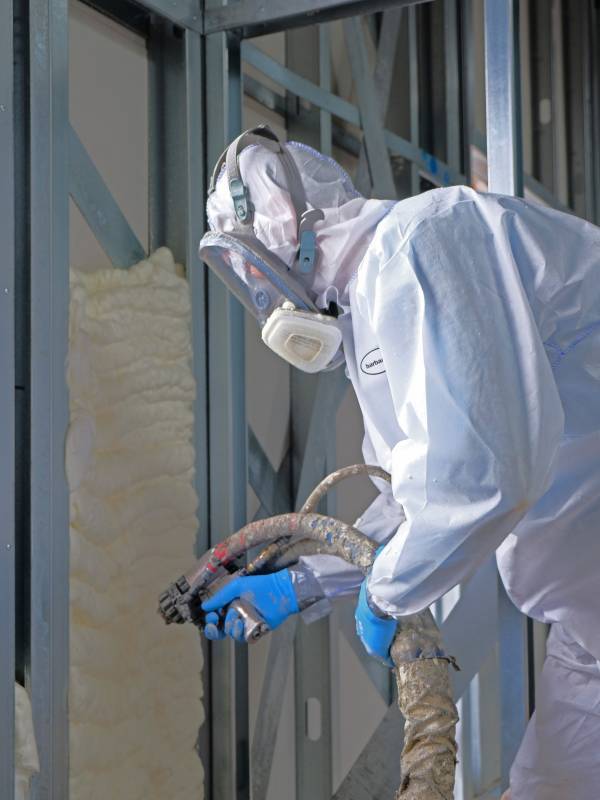AIR LEAKAGE. IT DOESN’T MATTER HOW LOW YOUR U-VALUES ARE IF THERE ARE DRAUGHTS.
4 Aug 2021

Paddy Leighton of Huntsman Building Solutions-Icynene, Spray applied insulation, explains why minimising air leakage must go hand in hand with better insulation.
Better insulation of domestic households is seen as one of the most important ways of reducing carbon emissions and slowing the effects of climate change.
A recent environmental audit select committee report says that 19 million UK homes are poorly insulated that unless urgent action is taken to improve energy efficiency of homes, the UK will fail to meet its climate targets.
Unfortunately, as over 60% of our current housing stock built pre-1960 when little thought was given to heat-loss prevention, the challenge is significant.
Overall, roughly 20% of UK carbon emissions are generated through heating, hot water and cooking in domestic properties. Even more troubling was the fact that in 2017, emissions from buildings actually rose by 1% over those of the previous year.
Basic principles
If we go back to basic principles; heat loss in a building occurs through a combination of four processes: conduction, convection, radiation and mass transfer. The colder the outside temperature, the warmer the inside, and the worse the thermal insulation of the building envelope, the greater the heat loss will be.
In the UK, the construction industry focusses primarily on U values - sometimes referred to as heat transfer coefficients- as a measure of conductive heat loss. These are used to measure how effective elements of a building's fabric are at insulating against heat loss. The lower the U-value of an element of a building's fabric, the more slowly heat is able to transmit through it, and so the better it performs as an insulator.
Very broadly, the lower the U-value, the less energy is required to maintain comfortable conditions inside the building.
Unfortunately, measuring the thermal efficiency of a structure by U-value alone fails to take into account of heat loss through air leakage. If you spend any time in high mountain environments you quickly realise that it is the wind that strips the heat from your body. And it is the same in buildings. It doesn’t matter what your U-value is if there are draughts.
Traditional forms of insulation are relatively inefficient in preventing air leakage through draughts. They can’t completely fill the complex voids in roof structures or seal the interface between the insulation and the building components. They can also struggle to cope with small structural movements which can lead to air gaps.
When 40 per cent of a building’s heat loss caused by air leakage, an insulation system that works to prevent air leakage – effectively creating a “sealed box” environment, is essential to minimise heat loss.
Spray applied, open cell insulation.
Breathable, open cell spray applied foams are highly efficient insulators against both conductive and convective heat loss as they control air movement and eliminate air leakage. Spray applied foam insulation is also extremely flexible; it moves with the structure, maintaining its insulative properties for the lifespan of the building.
Spray applied foam insulations such as HBS-Icynene Foam Lite are open cell materials which have a soft, yielding texture. This not only provides outstanding insulation properties, but also allows the building to breath naturally, resisting internal condensation – particularly important when insulating heritage-type buildings.
Control of air quality.
Heat loss through mass transfer is more complex and relates to how much moisture is held in the air (humidity). The more there is, the more energy it takes to heat it, so to feel warm, damp buildings need more energy than dryer ones.
To control humidity, you need to be able to control the air movement and you can only do this if the building is relatively airtight. Spray foam insulation does this effectively and quickly by sealing air gaps, enabling controlled ventilation and mechanical heat recovery systems to perform efficiently.
A wholistic approach to heat loss mitigation
High performance insulation, effective control of air movement and air quality, in combination with low carbon heating are interconnected elements that need to be addressed as-one in the design of new-build housing to ensure heat loss mitigation. Until Building Regulations take a wholistic view of this complex picture, the industry will continue to build housing that perform well in one respect but fail in others
From a wider perspective, bringing the UK’s legacy of pre-1960’s, poorly insulated housing stock up to a sufficiently high performance is a whole different ball-game, one that needs urgent attention at the highest level.
